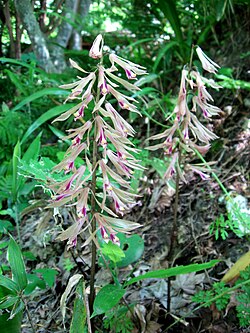| Cremastra appendiculata | |
|---|---|
 | |
| Scientific classification | |
| Kingdom: | Plantae |
| Clade: | Tracheophytes |
| Clade: | Angiosperms |
| Clade: | Monocots |
| Order: | Asparagales |
| Family: | Orchidaceae |
| Subfamily: | Epidendroideae |
| Genus: | Cremastra |
| Species: | C. appendiculata |
| Binomial name | |
| Cremastra appendiculata | |
| Synonyms [1] | |
| |
Cremastra appendiculata is an orchid species in the genus Cremastra . It is the type species of its genus.
There two subspecies: [1]
- Cremastra appendiculata var. appendiculata - Taiwan, Tibet, Yunnan, Bhutan, Assam, Nepal, Japan, Korea, Thailand, Vietnam
- Cremastra appendiculata var. variabilis(Blume) I.D.Lund - Kuril, Sakhalin, Japan, Korea, Thailand, Vietnam, Anhui, Chongqing, Gansu, Guangdong, Guangxi, Guizhou, Henan, Hubei, Hunan, Jiangsu, Jiangxi, Shaanxi, Shanxi, Sichuan, Zhejiang